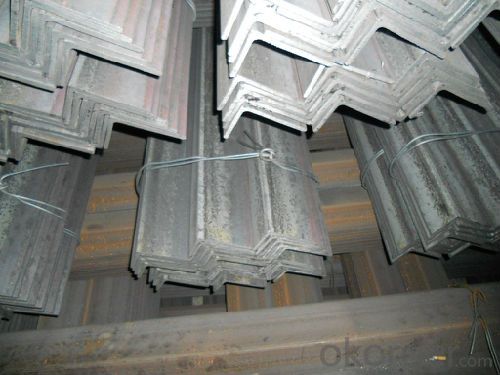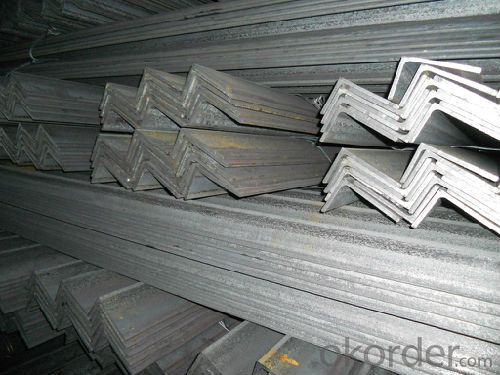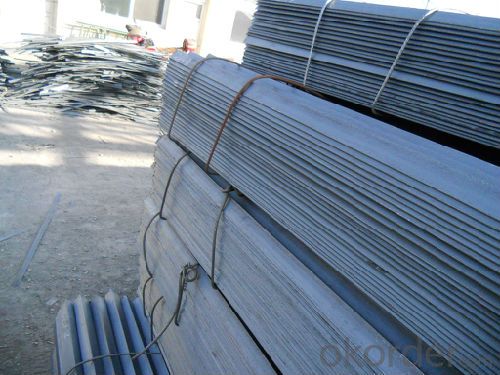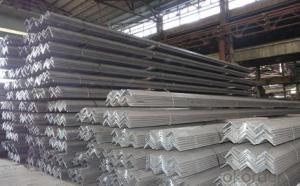Equal Angle Steel, American Standard Steel Angles, Carbon Steel Angle Iron
- Loading Port:
- Tianjin
- Payment Terms:
- TT or LC
- Min Order Qty:
- 25 m.t.
- Supply Capability:
- 35000 m.t./month
OKorder Service Pledge
OKorder Financial Service
You Might Also Like
Product Description:
OKorder is offering Equal Angle Steel, American Standard Steel Angles, Carbon Steel Angle Iron at great prices with worldwide shipping. Our supplier is a world-class manufacturer of steel, with our products utilized the world over. OKorder annually supplies products to European, North American and Asian markets. We provide quotations within 24 hours of receiving an inquiry and guarantee competitive prices.
Product Applications:
Equal Angle Steel, American Standard Steel Angles, Carbon Steel Angle Iron are ideal for structural applications and are widely used in the construction of buildings and bridges, and the manufacturing, petrochemical, and transportation industries.
Product Advantages:
OKorder's Equal Angle Steel, American Standard Steel Angles, Carbon Steel Angle Iron are durable, strong, and resist corrosion.
Main Product Features:
· Premium quality
· Prompt delivery & seaworthy packing (30 days after receiving deposit)
· Corrosion resistance
· Can be recycled and reused
· Mill test certification
· Professional Service
· Competitive pricing
Product Specifications:
1: Galvanized angle
2. Size: 20 x 20 to 200 x 200mm
3. Thickness: 3 to 24mm
4. Length: 5.8/6m,11.8/12m for bulk vessel
Key Specifications/Special Features:
Materials: ASTM A36, A572; Q235, Q345; SS400, Gr.50, EN 10056, S275, S355
Size: 20 x 20 to 200 x 200mm (Special size will be available as per request)
Thickness: 3 to 24mm (special size available as per request)
Length: 5.8/6m,11.8/12m for bulk vessel
Type: Equal
Primary Competitive Advantages:
· Form A
· Guarantee/Warranty
· International Approvals
· Product Features
· Prompt Delivery
· Quality Approvals ISO9001:2000
Application: construction Structural steel
Packaging Details: standard exporting package in bundle
Length*Length*THK(mm) | Weight(kg/m) | Length*length*THK(mm) | Weight(kg/m) |
25*25*3 | 1.124 | 70*70*6 | 6.406 |
25*25*4 | 1.459 | 70*70*7 | 7.398 |
30*30*3 | 1.373 | 70*70*8 | 8.373 |
30*30*4 | 1.786 | 75*75*5 | 5.818 |
40*40*3 | 1.852 | 75*75*6 | 6.905 |
40*40*4 | 2.422 | 75*75*7 | 7.976 |
40*40*5 | 2.976 | 75*75*8 | 9.030 |
45*45*3 | 2.088 | 75*75*10 | 11.089 |
45*45*4 | 2.736 | 80*80*6 | 7.376 |
45*45*5 | 3.369 | 80*80*7 | 8.525 |
50*50*3 | 2.332 | 80*80*8 | 9.658 |
50*50*4 | 3.059 | 80*80*10 | 11.874 |
50*50*5 | 3.770 | 90*90*6 | 8.35 |
50*50*6 | 4.465 | 90*90*7 | 9.656 |
63*63*5 | 4.822 | 90*90*8 | 10.946 |
63*63*6 | 5.721 | 90*90*10 | 13.476 |
63*63*8 | 7.469 | 100*100*6 | 9.366 |
70*70*5 | 5.397 | 100*100*7 | 10.83 |
70*70*6 | 6.406 | 100*100*8 | 12.276 |
Length*Length*THK(mm) | Weight(kg/m) | Length*length*THK(mm) | Weight(kg/m) |
100*100*10 | 15.12 | 160*160*10 | 24.729 |
100*100*12 | 17.898 | 160*160*12 | 29.391 |
110*110*7 | 11.928 | 160*160*14 | 33.987 |
110*110*8 | 13.532 | 160*160*16 | 38.518 |
110*110*10 | 16.69 | 180*180*12 | 33.159 |
110*110*12 | 19.782 | 180*180*14 | 38.383 |
125*125*8 | 15.504 | 180*180*16 | 43.542 |
125*125*10 | 19.133 | 180*180*18 | 48.634 |
125*125*12 | 22.696 | 200*200*14 | 42.894 |
125*125*14 | 26.193 | 200*200*16 | 48.68 |
140*140*10 | 21.488 | 200*200*18 | 54.401 |
140*140*12 | 25.522 | 200*200*20 | 60.056 |
140*140*14 | 29.49 | 200*200*24 | 71.168 |
FAQ:
Q1: Why buy Materials & Equipment from OKorder.com?
A1: All products offered byOKorder.com are carefully selected from China's most reliable manufacturing enterprises. Through its ISO certifications, OKorder.com adheres to the highest standards and a commitment to supply chain safety and customer satisfaction.
Q2: How do we guarantee the quality of our products?
A2: We have established an advanced quality management system which conducts strict quality tests at every step, from raw materials to the final product. At the same time, we provide extensive follow-up service assurances as required.
Q3: How soon can we receive the product after purchase?
A3: Within three days of placing an order, we will begin production. The specific shipping date is dependent upon international and government factors, but is typically 7 to 10 workdays.
Q4: What makes stainless steel stainless?
A4: Stainless steel must contain at least 10.5 % chromium. It is this element that reacts with the oxygen in the air to form a complex chrome-oxide surface layer that is invisible but strong enough to prevent further oxygen from "staining" (rusting) the surface. Higher levels of chromium and the addition of other alloying elements such as nickel and molybdenum enhance this surface layer and improve the corrosion resistance of the stainless material.
Q5: Can stainless steel rust?
A5: Stainless does not "rust" as you think of regular steel rusting with a red oxide on the surface that flakes off. If you see red rust it is probably due to some iron particles that have contaminated the surface of the stainless steel and it is these iron particles that are rusting. Look at the source of the rusting and see if you can remove it from the surface.
Images:



- Q:How do steel angles perform in high-wind regions?
- Steel angles perform well in high-wind regions due to their structural strength and ability to resist wind loads. The angled shape of the steel provides stability and prevents the structure from swaying or being damaged by strong winds. Additionally, steel angles are commonly used in the construction of buildings and structures in high-wind areas, such as hurricane-prone regions, as they offer excellent resistance to wind pressure. The high tensile strength of steel makes it highly resilient to the forces exerted by strong winds, ensuring the stability and integrity of the structure. Moreover, steel angles can be designed and engineered to meet specific wind load requirements, enabling them to withstand extreme weather conditions. Overall, steel angles are a reliable and effective choice for construction in high-wind regions, ensuring the safety and durability of the structures.
- Q:How do steel angles perform in extreme weather conditions?
- Steel angles have been specifically engineered to possess a remarkable level of durability and resistance towards severe weather conditions. Due to their exceptional strength and ability to endure harsh environments, they are commonly employed in construction and structural applications. When confronted with extreme weather events such as hurricanes, heavy snowfall, or strong winds, steel angles offer exceptional protection against these elements. The superior tensile strength of steel angles plays a pivotal role in their performance during extreme weather conditions. Their capacity to withstand significant loads and forces without distorting or fracturing makes them an ideal choice for enduring severe weather events. Moreover, steel angles are well-regarded for their outstanding resistance towards corrosion, a crucial attribute in areas characterized by high humidity, saltwater, or acidic surroundings. Another noteworthy aspect of steel angles is their remarkable versatility, as they can be easily fabricated and tailored to meet the specific requirements of a project. This adaptability ensures their suitability for a wide array of applications, including buildings, bridges, towers, and other structures that are exposed to extreme weather conditions. Furthermore, steel angles can be coated or treated to further enhance their resistance towards adverse weather conditions. For instance, the application of a galvanized coating can furnish additional protection against rust and corrosion, thereby prolonging the lifespan of the steel angles, even under the harshest weather conditions. In conclusion, steel angles have been meticulously designed to deliver exceptional performance in extreme weather conditions. Their remarkable tensile strength, corrosion resistance, and versatility establish them as a dependable choice for structures necessitating the ability to withstand hurricanes, heavy snowfall, strong winds, and other challenging weather events.
- Q:How do steel angles contribute to the resiliency of a structure?
- Steel angles contribute to the resiliency of a structure in several ways. Firstly, they provide additional structural support and stability by distributing the load across different members. Steel angles are often used as reinforcements or braces in construction projects, allowing for the transmission of forces and preventing excessive deflection or deformation. This helps to resist the impact of external forces such as wind, earthquakes, or heavy loads, enhancing the structure's overall resilience. Moreover, steel angles are highly durable and corrosion-resistant, which further adds to the resiliency of a structure. Steel, as a material, has exceptional strength and longevity, making it ideal for withstanding harsh environmental conditions and potential structural failures. This durability ensures that the structure can withstand the test of time, reducing the need for frequent repairs or replacements and improving its overall resilience. Additionally, steel angles offer flexibility in design and construction, allowing for efficient load transfer and optimized structural configurations. They can be easily customized and fabricated to meet specific project requirements, ensuring that the structure can be tailored to withstand various dynamic and static loads. This adaptability enhances the resiliency of the structure by enabling it to adapt to changing conditions or future modifications. Overall, steel angles play a crucial role in enhancing the resiliency of a structure by providing additional support, durability, and flexibility. Their ability to distribute loads, resist external forces, and withstand harsh conditions ensures that the structure can withstand unexpected events and maintain its integrity, making steel angles an essential component in resilient construction practices.
- Q:What are the different types of steel angles used in engineering?
- Engineering incorporates a range of steel angle varieties that enjoy common usage. These angles are typically fashioned from hot-rolled steel and come in various sizes and dimensions to suit diverse applications. Within engineering, different steel angle types are employed, including: 1. Equal angles: These angles boast identical sides and are frequently utilized for structural purposes, like supporting beams or columns. They furnish stability and strength to the structure and are commonly employed in construction ventures. 2. Unequal angles: As the name suggests, unequal angles feature sides of differing lengths. These angles are often employed in situations where one side must be longer or shorter than the other, such as bracing or framing. 3. L-shaped angles: L-shaped angles possess one side longer than the other, forming an L shape. They are frequently used in construction to offer support and reinforcement, particularly for corners, joints, or connections. 4. Structural angles: Structural angles are specifically designed to bear heavy loads and confer structural stability. They are commonly deployed in constructing frame structures, bridges, or other load-bearing applications. 5. Stainless steel angles: Stainless steel angles are fabricated from stainless steel, which delivers excellent corrosion resistance and durability. These angles are often employed in environments where rust or corrosion may be a concern, such as marine applications or food processing facilities. 6. Galvanized steel angles: Galvanized steel angles are coated with a layer of zinc to provide corrosion resistance. These angles are commonly used in outdoor applications or environments where exposure to moisture or harsh conditions is expected. 7. Perforated steel angles: Perforated steel angles feature holes or perforations along their length, facilitating enhanced ventilation or drainage. These angles are frequently employed in situations where airflow or water drainage is required, such as in HVAC systems or outdoor structures. Overall, the selection of a steel angle hinges upon the specific requirements of an engineering project. Factors such as load-bearing capacity, resistance to corrosion, and aesthetic considerations play a crucial role in determining the appropriate type of steel angle for a particular application.
- Q:Are there any special considerations when handling or installing steel angles?
- When handling or installing steel angles, there are several special considerations that need to be taken into account. To begin with, it is crucial to store and transport the angles correctly in order to prevent any damage. To avoid rusting, make sure to store the steel angles in a dry and well-ventilated area. When transporting them, ensure that they are properly secured to prevent accidents or injuries. Next, it is essential to install the steel angles on a solid and level surface to guarantee stability and proper distribution of the load. For accurate installation, it is recommended to use a level and plumb line. Furthermore, it is of utmost importance to use the appropriate size and type of fasteners when installing steel angles. The fasteners must be compatible with both the angle and the material it is being attached to. Additionally, ensure that the fasteners are tightened properly to avoid any loosening or failure. Moreover, the load-bearing capacity of the steel angles should be carefully considered. Select angles based on the expected load and the requirements of the application. It is advisable to consult with a structural engineer or a professional to determine the suitable size and type of steel angles for your specific project. Lastly, maintain safety precautions when handling and installing steel angles. Wear protective gear, such as gloves and safety glasses, to prevent injuries. Additionally, follow safe lifting practices and use appropriate lifting equipment for heavy steel angles. In conclusion, it is important to give due consideration to these special factors when handling or installing steel angles to ensure proper installation, structural integrity, and safety.
- Q:How do you measure the dimensions of a steel angle?
- To determine the dimensions of a steel angle, a combination of tools such as a measuring tape or ruler, a protractor, and a square can be used. Begin by measuring the length of one side of the angle using a measuring tape or ruler. Position the tape or ruler along the side of the angle and observe the measurement. Subsequently, measure the length of the other side of the angle in the same manner. Ensure that the starting point is the same as the first side for precise results. For measuring the angle itself, employ a protractor. Align the protractor's base with one side of the angle and verify that the other side corresponds to the appropriate degree marking on the protractor. Consult the protractor's reading to ascertain the angle of the steel angle. Lastly, a square can be utilized to confirm if the angle truly measures 90 degrees. Place the square against the two sides of the angle and confirm that it perfectly aligns with both sides. If alignment is achieved, then the angle is, indeed, 90 degrees. Please bear in mind that these measurements may be approximate and could slightly differ due to manufacturing tolerances.
- Q:What does "angle length" and "limb width" mean?
- Also available models that model is the number of centimeters wide, such as angle 3#. The model does not mean the size of the different edges and sizes of the same model. Therefore, the width, the edge and the thickness of the angle iron should be filled out in the contract and other documents, so as not to be indicated by the model alone. Standard Specification for hot-rolled equal angle iron is 2#-20#. The angle iron can be made up of different force components according to the different structure, and can also be used as the connecting piece between the components. Widely used in a variety of architectural and engineering structures, such as beams, bridges, towers, hoisting and conveying machinery, ships, industrial furnace, reaction tower, container frame and warehouse.
- Q:Can steel angles be used in the construction of conveyor systems?
- Yes, steel angles can be used in the construction of conveyor systems. Steel angles are commonly used as structural support in conveyor systems to provide stability and strength to the framework. They can be easily welded or bolted together to create the desired configuration for the conveyor system, making them a versatile and reliable choice in construction.
- Q:What is the maximum shear force for a steel angle?
- The maximum shear force for a steel angle depends on various factors such as the size, material, and specific design of the angle. It is typically determined through structural analysis and engineering calculations.
- Q:Can steel angles be used for manufacturing decorative brackets?
- Certainly! Decorative brackets can be manufactured using steel angles. These angles possess great versatility, allowing for effortless fabrication into a variety of shapes and sizes, thus making them ideal for the creation of decorative brackets. By cutting, welding, and forming the angles into diverse designs, one can achieve the desired aesthetic appeal. Moreover, steel angles offer exceptional strength and durability, guaranteeing the ability to support the weight of the objects they hold. Whether it be for architectural purposes or home décor, steel angles provide a dependable and economically viable choice for the production of decorative brackets.
1. Manufacturer Overview |
|
|---|---|
| Location | |
| Year Established | |
| Annual Output Value | |
| Main Markets | |
| Company Certifications | |
2. Manufacturer Certificates |
|
|---|---|
| a) Certification Name | |
| Range | |
| Reference | |
| Validity Period | |
3. Manufacturer Capability |
|
|---|---|
| a)Trade Capacity | |
| Nearest Port | |
| Export Percentage | |
| No.of Employees in Trade Department | |
| Language Spoken: | |
| b)Factory Information | |
| Factory Size: | |
| No. of Production Lines | |
| Contract Manufacturing | |
| Product Price Range | |
Send your message to us
Equal Angle Steel, American Standard Steel Angles, Carbon Steel Angle Iron
- Loading Port:
- Tianjin
- Payment Terms:
- TT or LC
- Min Order Qty:
- 25 m.t.
- Supply Capability:
- 35000 m.t./month
OKorder Service Pledge
OKorder Financial Service
Similar products
New products
Hot products
Related keywords



























